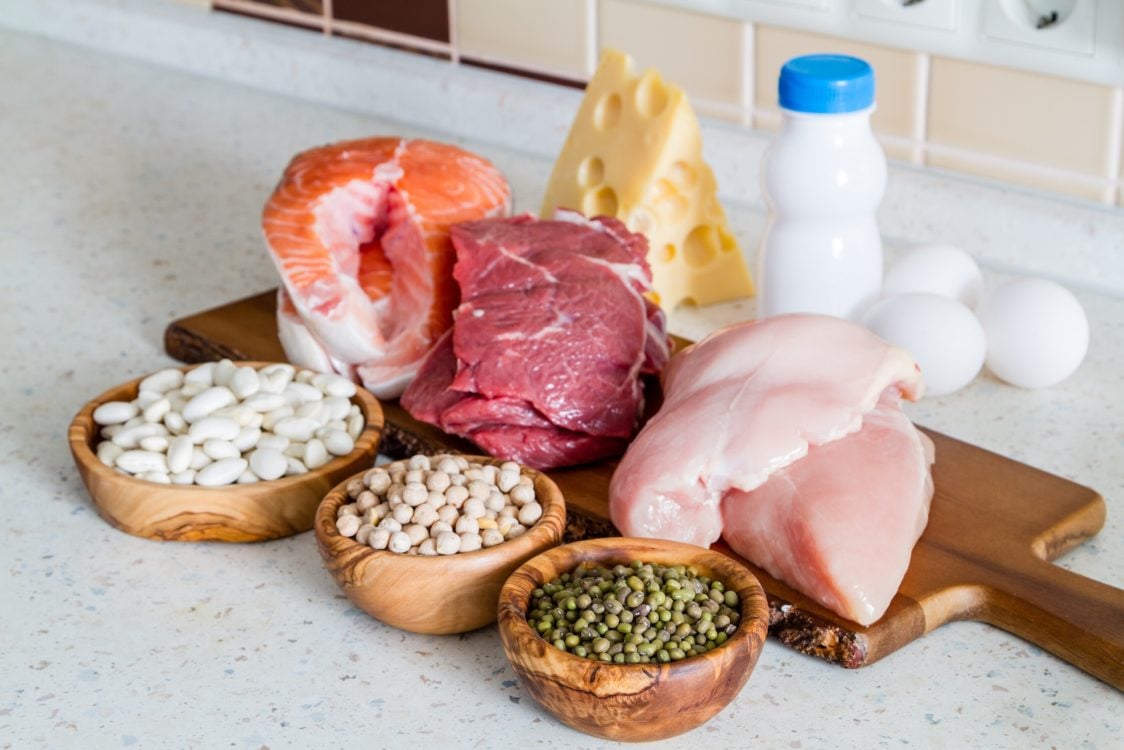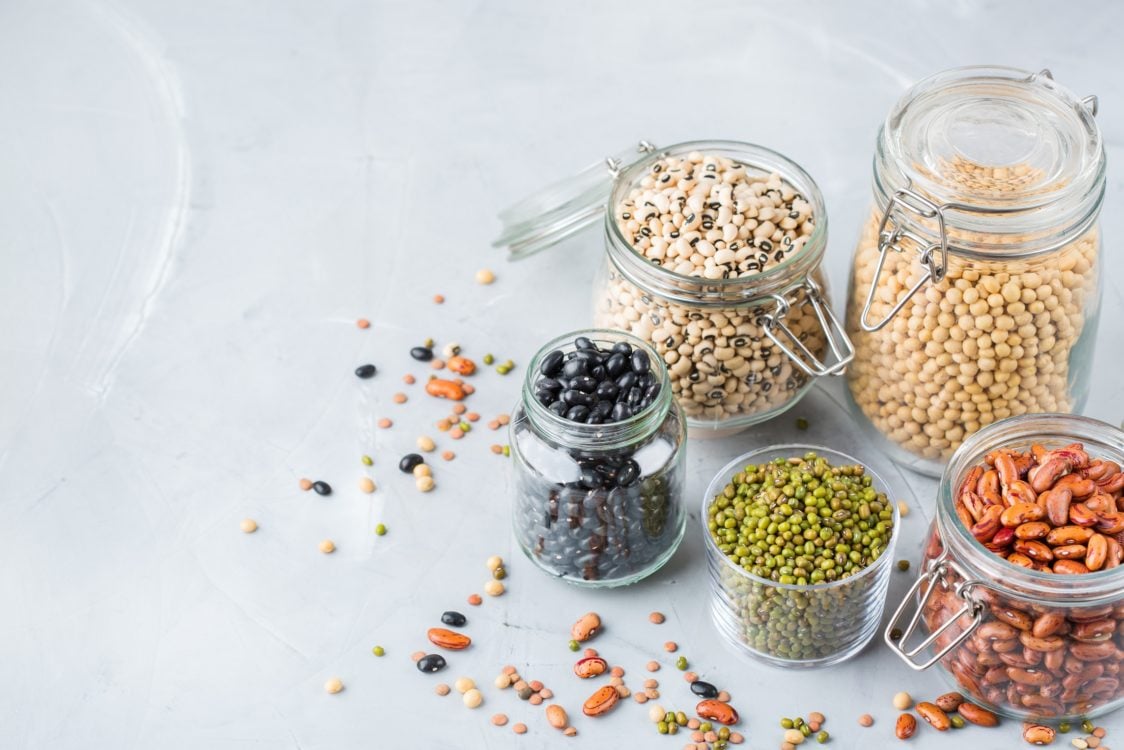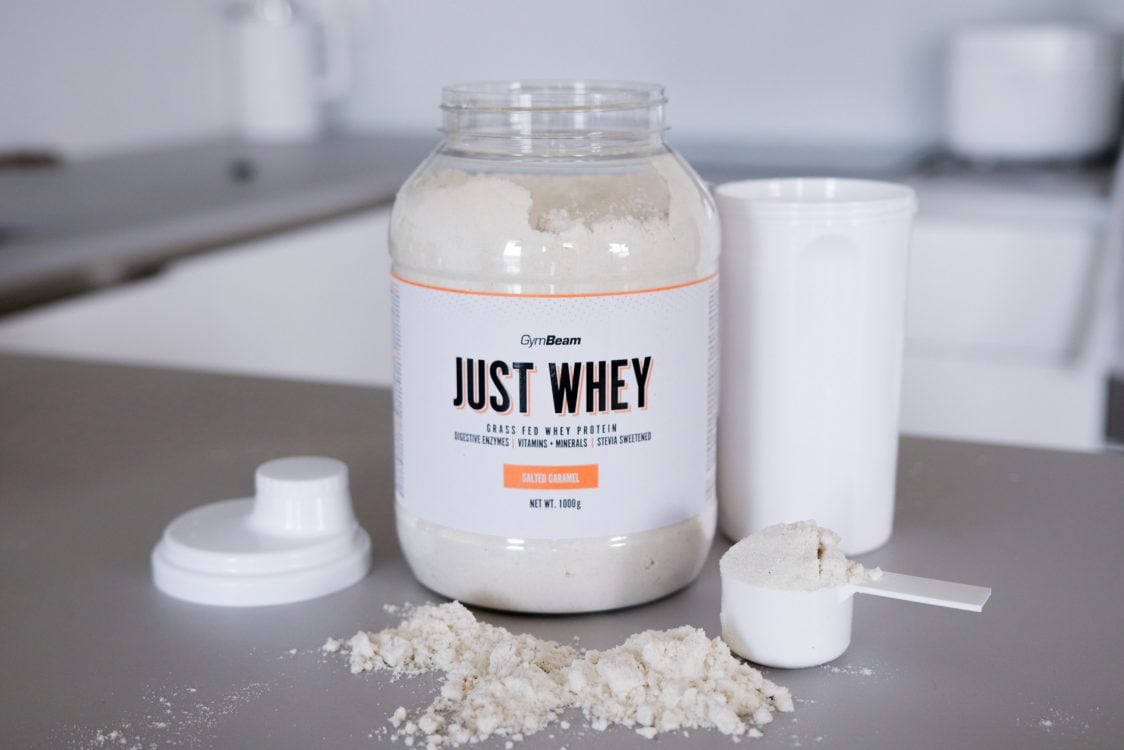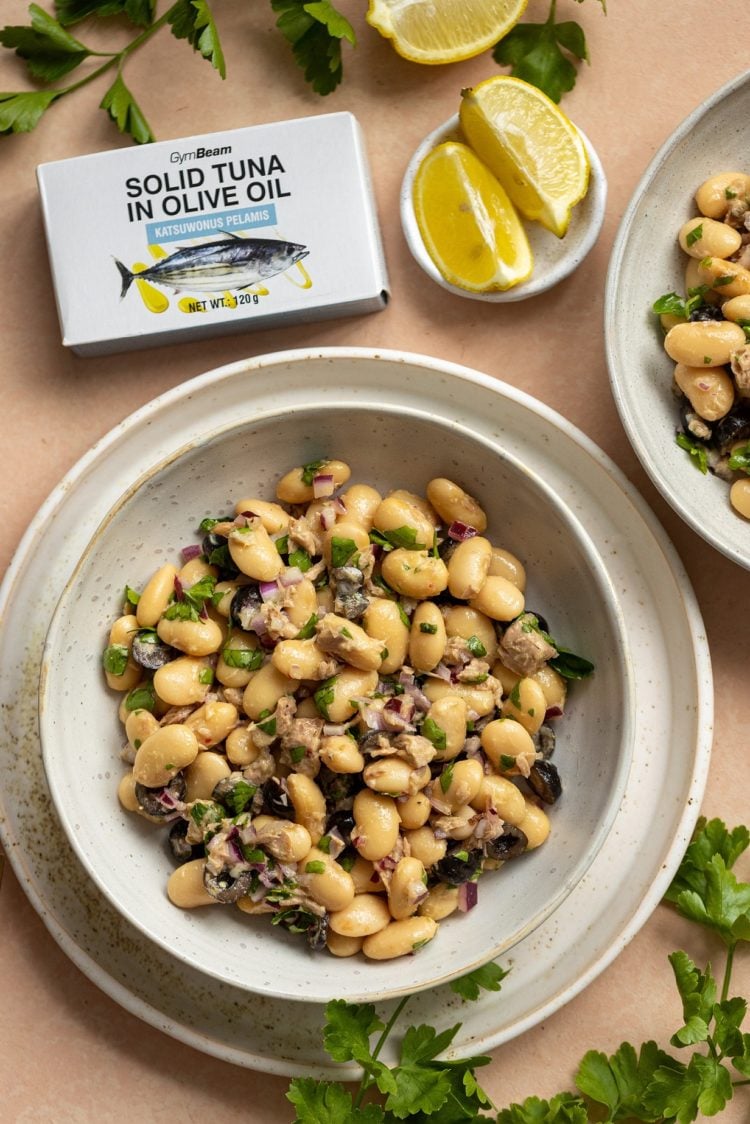Table of Contents
Out of the three macronutrients, which in addition to proteins also include fats and carbohydrates, proteins are probably the most well-known, especially in sports nutrition or when losing weight. The spotlight is rightly focused on them, as we need them not only for muscle growth, but also for the optimal function of the immune system and overall regeneration of the body. Today’s article will tell you what their other benefits are, what effect they have on health and how much of them you should ideally consume.
What is protein?
Protein is one of the three macronutrients in our diet, along with fats and carbohydrates. Since it is the basic building block of the body, its regular intake is essential for our health. It is used not only for the generally known muscle growth, but also for the formation of immune cells, enzymes, hormones and other necessary substances. [7]
Unlike carbohydrates and fats, our body is not able to create any larger reserves of protein, so its sufficient daily intake is all the more important. Free amino acids (also called amino acid pool) do circulate in the body and serve as an emergency reserve, but their quantity is limited. In the body of an average 70 kg person, they make up roughly 2% of the total amount of amino acids (approx. 200 g). [14]
According to the Dietary Guidelines for Americans for 2020–2025, in the average rational diet of an ordinary person, protein should make up 10–35% of the total daily energy intake (with a reference intake of 2000 kcal, this represents 50–175 g of protein). The energy value of 1 g of protein is 4 kcal (17 kJ), as in the case of carbohydrates, while 1 g of fat has 9 kcal (37 kJ). Protein can be found in both animal and plant-based products. [8,22]
Animal sources of protein include, for example:
Plant sources of protein include, for example:
- Legumes and products made from them
- Cereals
- Nuts and seeds
- Plant-based meat substitutes, such as tempeh, tofu, seitan, or Robi “meat”
Although both food groups contain protein, animal sources are better, as they have a superior nutritional profile. [7]

What is protein made of?
The basic building block of protein are amino acids (AA). They are interconnected with the so-called peptide bond and form chains called peptides. Only chains with a number of amino acids greater than 100 are considered proteins. Our body needs only 20 so-called proteinogenic amino acids to create all protein it needs for its proper functioning. Such a low number is truly admirable because, as you’ll discover below, the body uses protein for countless purposes.
For a better understanding, imagine protein chains, for example, as different letters connected to each other by a string. The letters represent individual amino acids, while the strings that hold them together are the aforementioned peptide bonds. Amino acids can be joined in this way in various combinations and form chains of various lengths. Each of the created versions can have a different role. For example, one chain may form an enzyme that helps digest food, while another may be part of muscle mass.
According to the number of amino acids in the chain, we distinguish:
- Oligopeptides which contain 2-10 amino acids.
- Polypeptides which are composed of 11-100 amino acids.
- Own proteins which are made up of more than 100 amino acids.
What are the types of amino acids?
The mentioned 20 amino acids important for our life are divided into several groups. Our body can produce some on its own, while other ones must be obtained from the diet or with the targeted help of nutritional supplements.

1. Essential amino acids (EAA)
Our body cannot produce them and therefore must receive them in the form of food.
Essential amino acids are:
- Leucine
- Isoleucine
- Valine
- Lysine
- Methionine
- Phenylalanine
- Threonine
- Tryptophan
Interestingly, leucine, isoleucine and valine are a type of amino acids known as BCAA (Branched Chain Amino Acids), which are widely used in sports nutrition.
2. Non-essential amino acids
Non-essential amino acids include:
- Alanine
- Asparagine
- Cysteine
- Glutamine
- Glycine
- Aspartic acid
- Glutamic acid
- Proline
- Serine
- Tyrosine
3. Semi-essential (conditionally essential) amino acids
Those are the ones that humans need to ingest in the form of food only in certain periods of life (e.g. in childhood). [7]
Semi-essential amino acids include:
- Arginine
- Histidine
You might be interested in these products:
Types of proteins according to their amino acid content
We don’t mention different types of amino acids for nothing. Essential and non-essential amino acids are found in protein-rich foods in various proportions and combinations which affect the quality of the protein itself.
- Complete proteins are those that contain essential amino acids in the optimal amount and ratio. They best meet the needs of our body. They mainly include animal foods, and some plant sources, such as soy, chickpeas or quinoa.
- Incomplete proteins don’t have a balanced amount of essential amino acids, which reduces their quality.Most plant foods are considered incomplete sources.
How do plant and animal sources of protein differ?
Both plant and animal products can be rich in protein. However, it is generally true that the animal ones are of better quality than the plant ones, because they have a more suitable spectrum of essential amino acids for the needs of our body. However, that doesn’t mean that plant foods don’t contain some of these amino acids at all. Most of them are found in every plant protein source, but in insufficient quantities. These missing amino acids are called limiting amino acids. Fortunately, each group of plant foods lacks different amino acids, so with an appropriate combination of plant sources, you can almost get rid of this issue. For example, cereals lack the amino acid lysine, while legumes lack methionine. By combining them, you can create a suitable AA spectrum.
A balanced content of EAA is important mainly because proteins with their optimal ratio are better utilized in the body (easier transformation into muscle proteins, etc.). [7,26]
However, it is also important to mention that plant sources also differ from animal sources in their lower absorbability. They contain anti-nutritional substances that can reduce the absorbability of their proteins. Fortunately, we can partially alleviate this disadvantage with some kitchen magic. You can reduce the amount of anti-nutritional substances, for example, by soaking the food before cooking it (discard the water afterwards), by sprouting or even by the cooking itself. [15,24]

How to get enough essential amino acids from plant-based protein sources?
The insufficient content of essential amino acids in plant foods is the reason it is recommended to plan your diet properly, especially for people whose diet is based on them. The diet of such a person should contain a varied spectrum of plant foods on a daily basis in order to cover the need for all essential amino acids.
It can be achieved, for example, by combining cereals and legumes, as these food groups complement each other in the content of essential AAs. However, this doesn’t mean that it is necessary to have both groups in one meal (although it is the most practical and ideal). Just make sure that the intake is sufficient throughout the whole day. This applies especially to vegans, as vegetarians consume dairy products (or fish, eggs), which are complete protein sources.
How to combine plant-based protein sources?
| Source | Missing amino acid | What types of food to combine them with to supplement the missing amino acid? |
|---|---|---|
| Cereals | Lysine, Threonine | Legumes |
| Legumes | Methionine | Cereals, nuts, seeds |
| Nuts and seeds | Lysine | Legumes |
How to determine protein quality?
As you can see, the quality of individual proteins varies. But don’t worry, there are several methods to figure it out.
- The biological value monitors the usability of proteins according to how much nitrogen is excreted from the body. It is because proteins contain nitrogen and this method is based on the idea that the proteins from which the excreted nitrogen comes were used in the body to create proteins. However, this is a relatively imprecise measure, because proteins can be used, for example, as a source of energy or for other purposes. The foods with the highest biological value are whey protein and eggs. [23]
- The Amino Acid Score (AAS) compares the content of essential amino acids in the monitored protein with the reference protein, which is defined by the World Health Organization (WHO). In this ranking, proteins can reach values of 0-1 and it indicates how good each protein source is. Eggs and milk are among the best quality ones. [16]
- Apart from the essential amino acids amount, it is also possible to measure their digestibility, which is done through the PDCAAS (Protein Digestibility-Corrected Amino Acid Score) method. Here, too, proteins can reach values of 0-1. Higher value = higher quality and better digestibility of the protein. Among the best sources from this point of view are whey protein or eggs. [11,22]
- The DIAAS (Digestible Indispensable Amino Acid Score) method takes into account the digestibility of proteins in the small intestine. It is assumed that only proteins absorbed in this way are used for the creation of body proteins. Whey protein, milk and egg continue to hold the leading positions. [9,23]

Protein metabolism: What do proteins do in the body?
Digestion of proteins begins already in the stomach. Stomach cells produce the so-called pepsinogen, which is subsequently converted into the enzyme pepsin thanks to gastric hydrochloric acid. It begins to split protein chains into shorter sections. Pepsin loses its abilities when, together with the partially digested contents of the stomach, it reaches the digestive tract, namely the small intestine. There, the digestive enzymes of the pancreatic juice (e.g. trypsin, chymotrypsin or elastase) take over and split the chains (polypeptides) into shorter oligopeptides. These are then split into the smallest units by enzymes stored in the intestinal mucosa – dipeptides, tripeptides and individual amino acids that are gradually absorbed into the bloodstream. [2]
Amino acids that are absorbed into the blood are used for several purposes. Some of them are used to create new proteins (e.g. during growth, tissue regeneration, etc.). Others are used, for example, to create non-protein substances, such as biogenic amines or creatine. Some amino acids are also used as an energy source if other energy sources (fats, carbohydrates) are exhausted. Then the so-called glucogenic amino acids can be converted to glucose. Branched-chain amino acids (BCAAs) can also function as a quick source of energy, for example during sports performance. [8]
Functions of protein in the body
Protein has countless functions in the body. Perhaps everyone who has ever been interested in nutrition knows that this nutrient is necessary for the growth and maintenance of muscle mass. However, it’s definitely not its only function. It would actually be quite difficult to find a process in which protein wouldn’t play at least some role.

The effect of protein on overall health
- Proteins are the basic building material of all tissues and organs. They form not only muscle mass, bones, skin, tendons, ligaments, etc. In these body parts collagen, which makes up almost a third of all proteins in the body, is found.
- Since proteins are contained in all the mentioned parts of the human body, they are also necessary for its growth and development.
- Without proteins, regeneration processes (for example, muscle mass after sports performance), as well as wound healing after an injury, would not be possible.
- Proteins even drive various important biochemical reactions. This is due to the fact that the enzymes responsible for this are mostly proteins. For example, they participate in the generation of energy inside the cells. However, they also play important roles outside the cells, for example as digestive enzymes. [4]
- The immune system or blood clotting would also not function properly without proteins.
- Proteins also help carry information between different areas of the body. The role of postmen, which ensures this transfer of information, is performed by substances called hormones. Most hormones are made up of proteins and polypeptides. [3,13]
- Proteins also have the role of transporting nutrients throughout the body. Without them, the body would not be able to transport oxygen or move cholesterol or sugar from the blood into the cells.
Protein and weight loss
Proteins play an irreplaceable role in weight loss. It’s not a coincidence that many diets are based on them, including those high-protein diets promising miracles. However, we are definitely not trying to encourage you to lose weight in a such manner. These diets are usually initially effective, but become unsustainable in the long term and lead to a yo-yo effect. Fortunately, however, proteins have a positive effect on weight loss even when they are part of a balanced diet for weight loss without any extremes. What are the benefits?
- Sufficient protein intake supports the growth of muscle mass. The goal of weight loss should ideally be to reduce the amount of body fat and maintain or build muscle (which is possible even with a caloric deficit, but not without sufficient protein intake and strength training). Without protein, these changes are simply impossible.
- Muscle mass, which thanks to proteins can be maintained or even increased, consumes quite a lot of energy. The more muscles you have, the more energy you burn by just maintaining the vital functions of our body. In other words, you have a higher basal metabolic rate. [7]
- Proteins have the highest thermic effect of all nutrients. This means that you burn the most energy when digesting them. This amount represents up to 20-30% of the total energy intake from protein. From 100 kcal in the form of protein, you’ll use approximately 70-80 kcal, depending on the type of protein.
- Protein intake also affects appetite, probably due to the effect on the function of hormones that send satiety notifications to the brain, such as cholecystokinin or glucagon-like peptide 1 (GLP-1). Proteins have the highest satiating capacity of all macronutrients. [5,19]
- Sufficient amount of protein in the diet thus helps prevent hunger even with reduced energy intake, which is necessary to successfully lose weight.
Proteins also reduce the glycemic index of foods. This means that they slow down the absorption of carbohydrates from the gut into the blood, thus slowing down the rise in blood sugar after a meal. This is how they prevent sharp fluctuations in the blood sugar level (glycaemia), which are associated with frequent sweet cravings.

How does protein affect sports performance?
If you want to achieve your exercise goals, sports and proper nutrition should go hand in hand. Proteins play an irreplaceable role here, especially in the case of strength sports. However, they can also do a thing or two for endurance sports.
1. Protein and strength training
- A properly chosen protein intake enables the growth of muscle mass. Its optimal amount depends on the type of sports activity and its frequency and intensity, as well as on the athlete’s body composition and goals. However, the general rule of thumb is to consume more protein to build new muscles than our body needs to maintain the ones it already has. But bear in mind that protein is not the only important nutrient for building muscle. An optimal intake of carbohydrates, fats and other nutrients is also important. [10,26]
- Two processes are constantly taking place in the body – MPS (Muscle Protein Synthesis) and MPB (Muscle Protein Breakdown). These two processes compete with each other and it is up to you in which direction you tip the scales. If you take in a sufficient amount of protein and energy and support the muscles with strength training, you can prevent the breakdown of proteins and support their creation. [25]
- Optimal protein intake also helps to protect muscle mass. As a result of demanding intense sports performance, during a caloric deficit or, for example, during an illness, proteins from muscles can be used as a source of energy. However, the more protein you get from your diet, the less protein you will lose from muscles. [25]
- Proteins are also essential for muscle regeneration. After exercise, muscles are not only regenerated, but can also become larger and stronger through this process. Proteins serve as a building material in this restoration of muscle mass. [10]
- Proteins play a role in other tissues as well. Sport is demanding not only for muscles, but also for bones, tendons, ligaments, etc. An adequate amount of protein in the diet helps to keep these parts of the body in good condition and helps with their healing after an injury.

2. Protein and endurance training
Some of the above-mentioned effects of proteins are also valid for endurance sports. Runners, cyclists and other endurance athletes will especially appreciate the effect of proteins on the regeneration and protection of muscles during exercise. Even though the protein consumption during activity probably doesn’t support the performance itself, it can help reduce the breakdown of muscle protein as a result of strenuous exercise. It can also help with muscle regeneration after exercise, similar to what happens in strength sports. [10]
Foods rich in protein
As already mentioned, proteins can be obtained from both animal and plant foods. However, individual food groups differ in the amount of protein and its quality.
1. Animal foods
These protein sources are generally considered as complete due to the optimal ratio and amount of essential amino acids. On average, how much protein do individual foods and food groups contain?
| Food Group | Average Protein Content per 100 g |
|---|---|
| Meat | 26 g |
| Ham (at least 90% meat) | 19 g |
| Fish | 22 g |
| Eggs | 12 g |
| Dairy and Sour Products | 3–4 g |
| Cheeses | 20–30 g |
2. Plant foods
Since plant foods are not perfect in regard to essential amino acids, they are generally considered incomplete. However, there are exceptions that stand out from the crowd and come close to animal protein sources in terms of amino acid content. These include, for example, soy, chickpeas and pseudocereals (amaranth, quinoa). [15]
| Food Group | Average Protein Content per 100 g |
|---|---|
| Legumes | 20 g |
| Pseudocereals | 15 g |
| Cereals | 13 g |
| Nuts and Seeds | 15–20 g |
| Meat alternatives (tofu, tempeh, seitan, robi meat, etc.) | 15–25 g |
If you want to add new protein foods to your diet, get inspired by our article Foods that Make It Easy to Add Protein to Your Diet.
The following articles can help you navigate plant-based protein sources:
- What Are the Best Sources of Plant Proteins and Why Include Them in Your Diet?
- Plant-Based Meat Alternatives: Which Are the Best, How Much Protein Do They Contain and Can They Fully Replace Meat?
How much protein to consume per day?
Proteins generally make up 10-35% of our daily energy intake. However, a specific recommendation that would apply to everyone doesn’t exist, because protein intake is very individual and depends on many factors.
The need for protein depends on your:
- Age
- Health condition
- Amount of muscle mass
- Amount of physical activity
- Type of physical activity
- Frequency and intensity of exercise
- Goals (losing weight, gaining muscle mass, maintaining weight, etc.)

If you don’t want to worry about specific numbers, use our online calculator to calculate your recommended energy intake and amount of nutrients. However, if you want to know more about this topic, keep reading.
The basic recommendation says that everyone should consume at least 0.8 g of protein / kg of body weight per day. However, the amount of 1 g of protein / kg of body weight appears to be more suitable. For a woman weighing 60 kg, this represents a daily intake of 60 g of protein. However, this is an amount that might be enough for a person who generally doesn’t move much, doesn’t play any sports and doesn’t live an active lifestyle. [10,12,26]
It’s different for someone who is more physically active or even does sport purposefully. In this case, the recommended amount increases up to 1.4-2 g / kg of weight, while it is recommended to try to go for the higher values. For a sports woman weighing 60 kg, this represents 84-120 g of protein.
If the same woman would like to gain muscle mass, she could benefit from a higher intake in the form of 1.6-2.4 g of protein/kg (96-144 g of protein). Higher values may be appropriate when undergoing a very demanding training schedule. The range of 1.6-2.4 g of protein/kg is also recommended for weight loss, especially for people who are already slim and just want to tone their body. For overweight and obesity, it is recommended to take 1.2-1.5 g/kg of the actual body weight daily. [25]
| Activity Level | Recommended Protein Intake |
|---|---|
| Sedentary lifestyle | 0.8–1 g/kg |
| Active lifestyle | 1.4–2 g/kg |
| Muscle mass gain | 1.6–2.4 g/kg |
| Weight loss | 1.6–2.4 g/kg |
Should you supplement protein?
Sometimes it can be really difficult to get enough protein through regular food. For example, if you are travelling or have a busy working day, it is useful to have something that will fill you up and replenish your proteins. Of course, the first step should always be a high-quality and varied diet, in which the main source of protein is food like meat, fish, dairy products, legumes, etc. However, if necessary, you can easily supplement it with various other protein foods. Not to mention the fact that these goodies will provide you with quality nutrients, and also satisfy your cravings for sweet and savoury treats.
For this purpose, it’s always good to have, for example:
Our article How to Choose a Good Protein Bar will help you choose the best product.

When to use protein powders?
Protein powder is a supplement that you mix with water and drink after a workout. It can also have its place in your diet, as it is great as a quick source of protein after a workout, or you can add it to your daily meals (for example, as a source of protein in oatmeal).
- Whey protein is considered the first and best option, as it has an optimal and balanced ratio of amino acids, and many other health benefits.
- Many other plant-based proteins are also an option. Soy, hemp or others can do wonders in the diet of vegans.
If you choose correctly, protein powders can be a pleasant addition to the diet and serve as a high-quality protein supplement. It is perfectly fine for them to appear regularly in your diet, as long as they are really just a supplement and not a replacement for other sources of protein.
- The article How to Choose the Best Protein Bar for Weight Loss will tell you how to choose the best protein powder.
- Article entitled Which Protein Powder Should You Choose? Whey Concentrate, Isolate or Hydrolysate? can help you choose from different types of whey protein.

What are the risks of insufficient protein intake
With insufficient protein intake, there is an increased risk of disruption of some important processes in the body for which proteins are necessary.
- It is not possible to build muscle mass (hypertrophy), but on the other hand, it can definitely decrease (atrophy).
- Since proteins are the building material of other tissues as well, a deficiency can be manifested by an increased risk of fractures, skin changes or, for example, hair loss.
- Insufficient protein intake can be more extreme, especially in the elderly population or in people with diseases that require an overall higher intake of energy and nutrients, including protein (e.g. cancer). In these cases there is a risk of so-called sarcopenia – The gradual loss of muscle mass and its function and the risk of injury or even death increases. [6]
- Immunity disorders or impaired wound healing can also be one of the symptoms.
- Insufficient protein intake can also be manifested by fatigue or mood swings.
- Swollen feet or hands may also indicate that protein intake is not sufficient.
- Missing protein in the diet is often expressed in the form of increased hunger and sweet cravings. [20,21]

Is excessive protein intake harmful?
Some sources mention that excessive protein intake damages the kidneys or causes osteoporosis. However, these claims are in the realm of myths, because they have no support in scientific works. According to the currently available studies, protein intake that exceeds the recommended amounts does not appear to be a health risk for healthy, active individuals. An intake of more than 3 g of protein / kg of weight, which is three times the amount compared to the amount generally recommended for the majority of the population, has been tested in studies without any negative effects observed. [1,5,10]
Of course, if a person is being treated for kidney disease (for example, suffering from chronic renal insufficiency), it’s a completely different situation. Then the limited amount of protein in the diet is in place and is part of the treatment. [5]
So you definitely don’t have to worry about a higher protein intake. Don’t panic even if you find out from your lab results that you have a certain amount of protein in your urine. Proteins get from the blood to the urine when the blood passes through the kidneys. Only when the kidneys let through larger amounts of protein, it indicates a health problem. However, you don’t have to worry that you could cause it with a high protein intake. Up to 30 mg / g of protein in urine can appear even in healthy individuals. [27]
So if you indulge in a higher than recommended intake of this nutrient and you are a healthy active person, don’t worry about harming your health. You are unlikely to reach the amount of 3-4 g/kg of body weight anyway, which are the values observed in the mentioned studies. However, if you would like to try it, the question arises as to what the point would be. A significantly higher protein intake compared to what you need may be simply unnecessary. As in the case of fat and carbohydrates, their excess intake can only be used as a source of energy.
How to eat more protein and meet its recommended intake?

- Add a source of protein to every meal. The article What Is a Healthy Diet and How to Learn to Eat Healthily? can help you put together a meal plan.
- Treat yourself to at least 20-25 g of protein in each main meal (taking into consideration your overall need). However, if you do sports, especially strength training, you could benefit from the intake of up to 40 g of protein per serving. [10,17]
- If you’re not having any meat for lunch, find a sufficient substitute, for example in the form of fish, eggs, plant-based alternatives to meat, etc. Be sure not to eat only the side dish and certainly not the vegetable salad itself.
- Instead of classic wheat flour, sometimes you can also use, for example, legume or buckwheat flour.
- A regular intake of legumes, legume pasta or pseudocereals can also help with higher protein intake.
- To help you meet the recommended intake, well-thought-through snacks can also help. You can prepare a source of protein, such as sour milk products (yogurt, kefir milk, buttermilk, etc.), quark cheese, skyr, etc. and add fruit or oatmeal. For the savoury version, you can’t go wrong with, for example, preparing some whole grain bread with high-quality ham and cheese as a source of protein.
- Use them as an opportunity to include beneficial cultured milk products (yogurt, kefir milk, buttermilk, etc.)
- You can easily supplement protein with Greek yogurt, skyr or quark cheese. It is recommended to always have these foods in the fridge, because they can be used as a simple snack and don’t require any preparation.
- If necessary, supplement your diet with whey or vegan protein, or treat yourself to a protein bar or cookie.
- For more tips, read our article How to Sneak More Protein Into Your Diet?
What should I eat when I have trouble digesting certain foods?
- Lactose intolerance: If you have to limit dairy products for this reason, first of all find out if they are really harmful to you. For example, hard cheese or cultivated products contain a very small amount of lactose. If you really cannot tolerate any dairy product, reach for lactose-free products.
- Cow’s milk protein allergy: In this case, all foods containing milk protein must be eliminated. Use meat, ham, fish, eggs or plant-based sources instead.
- Celiac disease or gluten allergy: Use gluten-free pastries as a substitute for the ones that contain gluten. These include wheat, rice, corn, pseudocereals (quinoa, buckwheat, amaranth). Don’t forget legumes and, for example, various nut flours, which can be used instead of classic wheat flour.
Which protein sources are best and which to limit?
| Good | Bad |
|---|---|
| Lean meat (poultry, rabbit meat, turkey meat, lean pork and beef, etc.), fish (sea and freshwater), ham (with min. 80% meat content), eggs, dairy products (yogurts, kefir milk, cheese, quark, etc.), legumes and legume products, pseudocereals, plant-based meat alternatives (tofu, tempeh, robi, seitan, etc.) | Reduce your intake of fatty cuts of meat and meat products (salami, bacon, sausages, pâtés, sausages, etc.) |
Even though plant foods are mostly not complete, definitely don’t limit them. On the contrary, strive for as much regularity and variety as possible.
What should you remember?
In nutrition, proteins are rightly highlighted above all other macronutrients. They are not only the basic building block of the human organism, but also part of most processes in the body. Therefore, you should definitely pay attention to their sufficient intake, taking into consideration the current state of your body, as well as your goals. When preparing your diet, it is advisable to keep under control the total amount of protein, as well as the inclusion of foods that can provide you with all essential amino acids in the right amount and ratio. Ideally, choose from a wide range of foods of both animal and plant origin. And remember that you don’t have to be afraid of supplementing your diet with quality nutritional supplements.
[1] ANTONIO, J. et al. A High Protein Diet Has No Harmful Effects: A One-Year Crossover Study in Resistance-Trained Males. – https://pubmed.ncbi.nlm.nih.gov/27807480/
[2] BHUTIA, Y.D. - GANAPATHY, V. Chapter 47 - Protein Digestion and Absorption. – https://www.sciencedirect.com/science/article/pii/B9780128099544000475
[3] COOPER, G.M. Signaling Molecules and Their Receptors. In The Cell: A Molecular Approach. 2nd edition – https://www.ncbi.nlm.nih.gov/books/NBK9924/
[4] COOPER, G.M. The Central Role of Enzymes as Biological Catalysts. – https://www.ncbi.nlm.nih.gov/books/NBK9921/
[5] CUENCA-SÁNCHEZ, M. et al. Controversies Surrounding High-Protein Diet Intake: Satiating Effect and Kidney and Bone Health – https://pubmed.ncbi.nlm.nih.gov/25979491/
[6] DEUTZ, N.E.P. et al. Protein intake and exercise for optimal muscle function with aging: Recommendations from the ESPEN Expert Group. – https://pubmed.ncbi.nlm.nih.gov/24814383/
[7] DUYFF, R.L. Complete Food & Nutrition Guide. . New York: Academy of Nutrition and Dietetics, 2017. ISBN 978-0-544-52058-5.
[8] EUROPEAN FOOD SAFETY AUTHORITY Scientific Opinion on Dietary Reference Values for protein. – http://onlinelibrary.wiley.com/doi/10.2903/j.efsa.2012.2557/epdf
[9] GENONI, A. et al. Limitations of the Digestible Indispensable Amino Acid Score (DIAAS) and Choice of Statistical Reporting. Comment on “A Comparison of Dietary Protein Digestibility, Based on DIAAS Scoring, in Vegetarian and Non-Vegetarian Athletes – https://www.mdpi.com/2072-6643/12/4/1183
[10] JÄGER, R. et al. International Society of Sports Nutrition Position Stand: protein and exercise. – https://jissn.biomedcentral.com/articles/10.1186/s12970-017-0177-8
[11] JOINT FAO/WHO/UNU EXPERT CONSULTATION ON PROTEIN AND AMINO ACID REQUIREMENTS IN HUMAN NUTRITION – https://apps.who.int/iris/handle/10665/43411
[12] KERKSICK, C.M. et al. International society of sports nutrition position stand: nutrient timing. – https://jissn.biomedcentral.com/articles/10.1186/s12970-017-0189-4
[13] NUSSEY, S. - WHITEHEAD, S. Principles of endocrinology – https://www.ncbi.nlm.nih.gov/books/NBK20/
[14] PITKÄNEN, H.T. et al. Free Amino Acid Pool and Muscle Protein Balance after Resistance Exercise. – https://pubmed.ncbi.nlm.nih.gov/12750588/
[15] SÁ, A.G.A. et al. Plant proteins as high-quality nutritional source for human diet. – https://www.sciencedirect.com/science/article/abs/pii/S0924224419308994
[16] SCHAAFSMA, G. The Protein Digestibility-Corrected Amino Acid Score (PDCAAS)--a concept for describing protein quality in foods and food ingredients: a critical review. – https://pubmed.ncbi.nlm.nih.gov/16001875/
[17] SCHOENFELD, B.J. - ARAGON, A.A. How much protein can the body use in a single meal for muscle-building? Implications for daily protein distribution. – https://jissn.biomedcentral.com/articles/10.1186/s12970-018-0215-1
[18] STAFF, A.S.N. – https://nutrition.org/protein-complementation/
[19] WESTERTERP-PLANTENGA, M.S. et al. Dietary protein – its role in satiety, energetics, weight loss and health. – https://pubmed.ncbi.nlm.nih.gov/23107521/
[20] 7 Signs You’re Not Getting Enough Protein. – https://www.webmd.com/diet/ss/slideshow-not-enough-protein-signs
[21] 8 Signs and Symptoms of Protein Deficiency. – https://www.healthline.com/nutrition/protein-deficiency-symptoms
[22] Dietary Guidelines for Americans, 2020-2025. In . s. 164. – https://www.dietaryguidelines.gov/sites/default/files/2020-12/Dietary_Guidelines_for_Americans_2020-2025.pdf
[23] How can you assess protein quality? - Examine. – https://examine.com/supplements/whey-protein/faq/plqmpl6-how-can-you-assess-protein-quality/
[24] How to Reduce Antinutrients in Foods. – https://www.healthline.com/nutrition/how-to-reduce-antinutrients
[25] Optimal Protein Intake Guide - Examine. – https://examine.com/guides/protein-intake/
[26] What are Proteins and What is Their Function in the Body? – https://www.eufic.org/en/whats-in-food/article/what-are-proteins-and-what-is-their-function-in-the-body
[27] What is albuminuria? In National Kidney Foundation – https://www.kidney.org/atoz/content/albuminuria

